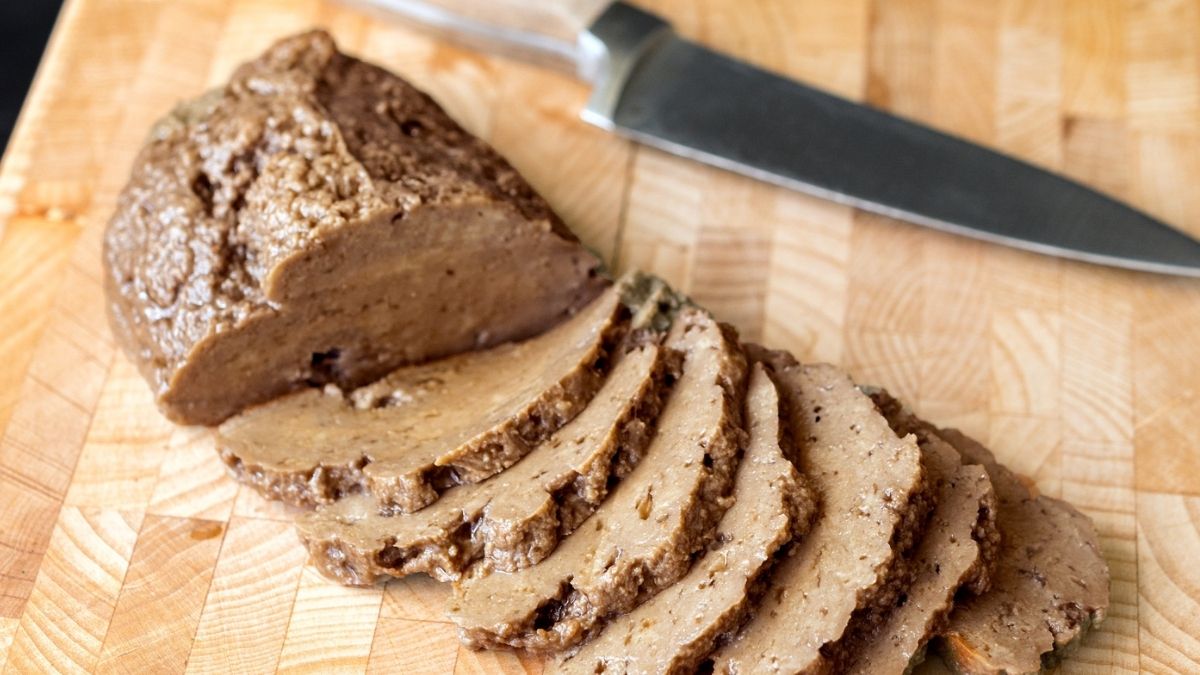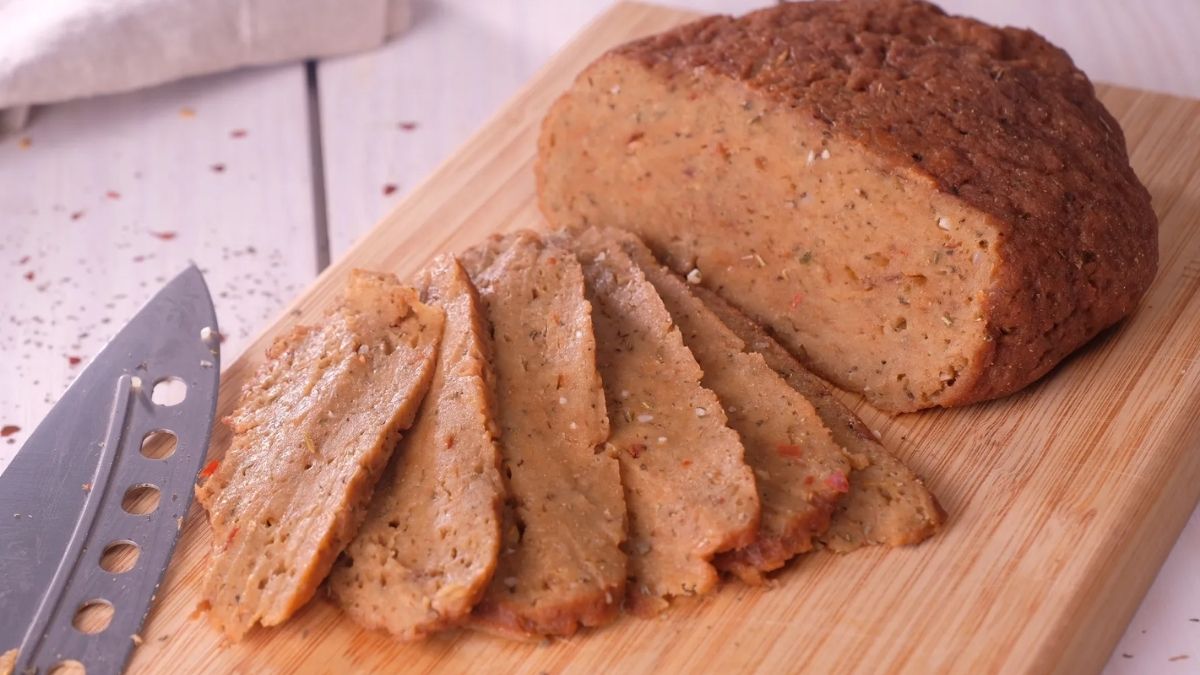“Wheat meat” has been around for hundreds of years, but the name “seitan” (which you say “say-tan”) is much newer. Seitan is made from wheat, but it is not like flour or bread. Seitan looks and feels a lot like meat when cooked, so vegetarians and vegans often use it as a meat substitute. It is also called wheat protein, wheat gluten, and gluten.
To make Eitan, wheat flour and water are mixed and kneaded until strands of gluten protein form in a sticky dough. The dough is then rinsed to remove the starch, leaving only the pure gluten protein mass. The protein can then be seasoned and cooked to replace meat in many plant-based dishes.
What is Seitan?
Seitan is the main ingredient in many vegetarian foods you can buy in stores, like Tofurky deli slices, meatless frankfurters, fakin’ bacon, etc. You can often find it in different forms, such as ground, sliced, or strips. Seitan can be made by hand with whole wheat flour, which takes a lot of work, or with vital wheat gluten (which is a much simpler process). It is made by rinsing the wheat dough to remove the starch, leaving only the high-protein gluten.
Seitan is a meat substitute made from vital wheat gluten flour that has been soaked in water and cooked. Gluten is a mix of the proteins prolamin and glutelin, found in wheat, barley, and rye, among other similar grains. It gives dough made from these grains its elasticity and helps keep the dough together. Seitan is often sold on its own, ready to heat up and add to recipes. It is also used as an ingredient in many ready-made plant-based meat products, like some burgers, hot dogs, and deli slices.
How to Make Seitan?
Seitan is easy to get today because most grocery stores sell it already made, and it is usually near the tofu and other meat substitutes made from plants. But you can also make it at home with only a few things.
All you need is vital wheat gluten, which comes in a dry powder form and is usually sold with nontraditional flours in the baking section, and a liquid, like water or vegetable broth. But many recipes also call for small amounts of nutritional yeast, liquid aminos, soy sauce, and herbs or spices like garlic powder and onion powder to give homemade Seitan more flavor. In some recipes, chickpea or soy flour is also used.
You have to mix all the ingredients to make a dough, cut the dough into pieces, and let them cook in liquid. After that, you can use your homemade Seitan in any dish. You can mix Seitan by hand, but the dough gets thick quickly, so it may be easier to use a countertop mixer.
Below is a basic recipe you can use to make Seitan at home.
Ingredients
- 1 cup (120 grams) vital wheat gluten
- 1/2 cup (120 mL) vegetable broth or water
- 1/4 cup (60 mL) soy sauce or liquid aminos
- Three tablespoons (15 grams) of nutritional yeast
- One tablespoon (14 mL) of olive oil
- One teaspoon (3 grams) of garlic powder
For the cooking broth:
- 4 cups (960 mL) of water
- 4 cups (960 mL) vegetable broth
- Optional: 1/4 cup (60 mL) soy sauce or liquid aminos
Directions
- Put all the seitan ingredients in a bowl and knead, either by hand or with an electric mixer, to make a rubbery dough.
- In the meantime, put all the ingredients for the cooking broth into a large pot and bring it to a boil.
- When the dough for your Seitan is ready, stop kneading it and take it out of the bowl. Cut it into three to five even pieces.
- Once your cooking broth is boiling, carefully put the pieces of seitan dough into the liquid. Slow it down to a simmer and put a lid on the pot.
- Let your seitan cook for an hour on low heat.
- When your Seitan is done cooking, use tongs or a slotted spoon to carefully lift it out of the cooking broth and place it on a cloth or paper towel to drain and cool. Once it has cooled, you can use it or store it in airtight containers for up to 3 days in the fridge.
What does it Taste Like?
Seitan has a taste similar to bland chicken or a portobello mushroom. Seitan has a mild taste on its own, but different recipes can give it a lot of different tastes. It can be spicy, like in “chicken wings” made with Seitan, or savory, like a delicious Indian or Thai massaman curry. Seitan is more popular because of how it feels than how it tastes. This is especially true compared to alternatives like tofu or tempeh, which don’t have a “meaty” texture.
According to many people, Seitan has a dense, slightly rubbery texture that makes it more like meat than tofu or tempeh. If you make it at home, you can add seasonings and sauces to make it taste even better. For example, nutritional yeast in your homemade dough can give your Seitan a cheesy, nutty flavor. By adding soy sauce, you can make it taste saltier. If you buy a seitan already made, you can make it taste better by marinating it or cooking it for a short time in vegetable broth.
What is the Nutrition Value of Seitan?
Seitan has a lot of protein and not too many calories, fat, or carbs, and it also has a lot of minerals.
Seitan has fewer calories and fat than beef loin, but it has almost the same protein. Seitan does have carbs in it, but beef does not. Even though the nutritional value of Seitan can vary by brand and by how it is made at home, here is an example of what you can expect from vital wheat gluten, which is the main ingredient in Seitan. Seitan’s main ingredient, vital wheat gluten, has the following nutritional value per 1/4 cup (28 grams):
- Calories: 104
- Fat: 0.5 grams
- Total carbs: 4 grams
- Fiber: 0.2 grams
- Protein: 21 grams
- Selenium: 16% of the Daily Value (DV)
- Iron: 8% of the DV
- Phosphorus: 7% of the DV
- Calcium: 4% of the DV
- Copper: 3% of the DV
Again, the nutritional value of Seitan can change depending on what other ingredients and flavorings are added. If you buy it already made, you can look at the list of ingredients and the nutrition information for each option.
The Protein Content of Seitan
Seitan is a good source of plant-based protein because it is made from gluten, the main protein in wheat and related grains. Depending on what ingredients were used to make it, the amount of protein in a serving of Seitan can vary. For example, seitan products made with soy or chickpea flour can be a good source of extra protein.
Most of the time, 15–21 grams of protein are in a 3-ounce serving of Seitan, and that’s about the same amount of protein as chicken and beef. Like all plant foods, Seitan has some of all nine essential amino acids. But basic Seitan may only have a little bit of lysine, and that means that you should get lysine from other foods, like beans, soy milk, tempeh, quinoa, and lentils.
How to Use Seitan?
Seitan always needs to be cooked before being used in a vegetarian or vegan meal, whether you make it yourself or buy it already made. One way to cook Seitan is to quickly fry it in a pan with a splash of tamari, soy sauce, or nama shoyu. You can make a tasty dish by simmering it with a little curry powder and topping it with nutritional yeast.
You can buy a seitan already made or make it at home. Either way, there are many ways to use it.
- sliced and layered onto sandwiches
- used as a ground beef substitute in spaghetti sauce or tacos
- sliced into strips for fajitas or stir-fry
- slathered with barbecue sauce and served as a main dish
- breaded and deep-fried like chicken strips
- simmered in hearty bean and vegetable stews
- threaded onto skewers with baby potatoes and vegetables and grilled as kebabs
Is Seitan Healthier Than Tofu?
But, as you can see, Seitan has a higher protein content and lower fat content than tofu. Tofu has a higher fat content than meat, and hence it has a lower total protein content. Each is available in low-fat and high-fat varieties. Seitan is a fantastic high-protein lean vegetarian protein source. Tofu and Seitan are both good vegetarian protein sources. Soybeans are used to make tofu, and wheat gluten is used to make Seitan. Both are readily available at supermarkets. The classic vegetarian protein is tofu.
Conclusion
Seitan is a popular meat substitute made from wheat gluten, water, and sometimes other ingredients that add flavor. It’s a good source of minerals like selenium and iron and is high in protein and low in fat and carbs. Seitan is a good choice for people who can’t eat soy since many popular vegan foods, like tofu and tempeh, are made from soy. But Seitan shouldn’t be eaten by people who can’t handle wheat or gluten, such as those with sensitivities, allergies, or celiac disease, because it could cause serious side effects.
Some people think that eating gluten might affect the gut’s health, but more research needs to be done. Overall, Seitan can be a good food choice if you’re looking for a high-protein plant-based meal alternative, as long as you don’t have to avoid wheat or gluten.

